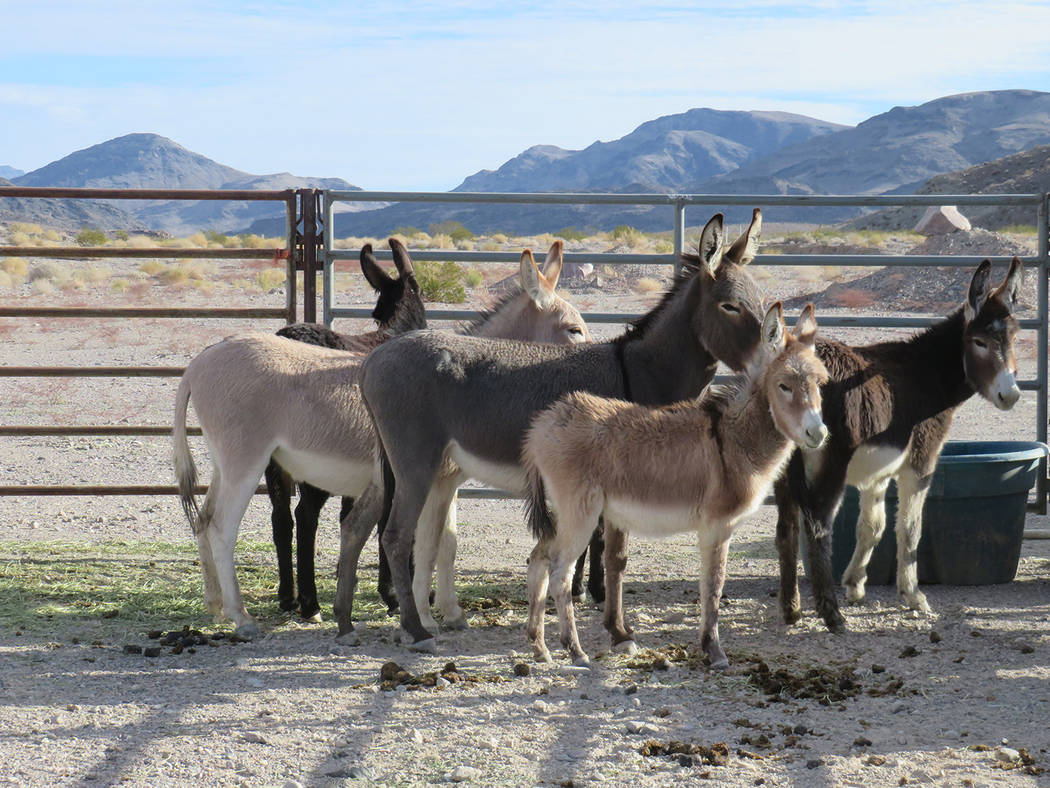
To the uninitiated, Jacks and Jennys are known as the wild burros who routinely roam around the outskirts of the Pahrump Valley.
Though the herds can be a pleasant and unforgettable sight to locals and those traveling through the area, officials at the U.S. Bureau of Land Management (BLM) maintain the animals can also wreak havoc on public lands and private vehicles.
Each year local emergency crews respond to motor vehicle collisions caused by the animals attempting to cross parts of Highway 160, as they forage for food and water, resulting in cars sustaining substantial damage while drivers and passengers at times suffer serious injuries from the incursions.
As such, BLM officials conducted a wild burro “bait and water gather” event northwest of town on Dec. 20, where at least 117 wild burros were gathered and transported to the Ridgecrest Regional Wild Horse and Burro Corrals in Ridgecrest, California.
All told, 74 adult males, 31 adult females and 12 foals were captured.
Great wide open
The gather, according to BLM Wild Horse and Burro Specialist Tabby Romero, took place on private land near the Johnnie Herd Management Area, consisting of 212,570 acres.
In all, 177,662 acres are managed by the BLM while 34,908 acres are managed by the U.S. Forest Service.
The gather was conducted in response to the safety concerns of the burros, the land and the public, as the burros were crossing Highway 160, entering private properties and causing damage to fencing, water lines, and vegetation, BLM officials maintain.
Burros foraging for food are also routinely struck by vehicles traveling along the highway.
Romero said all went well during the gathering event, as 117 of the animals were collected.
“We had the initial intention of gathering about 75, but when we found out about a new problem area for these burros, we requested to gather a little bit more,” she said. “We separated the Jacks from the Jennys in the holding area and loaded them onto a stock trailer where they were hauled out to the Ridgecrest Holding Facility in Southern California.”
A simple plan
Romero also made certain to note that the gather did not cause any undue stress on the animals.
“The gather essentially consisted of feed and water traps,” she said. “The contractors use a gate trap where the burros come in, the contractor presses a button, and the gates close behind them. The only time the animals are under any kind of stress is when they are getting loaded into the trailer but that stress is very minimal.”
Romero also noted that public outreach continues to play an important role in dealing with the problem burros, as travelers and local residents are prone to feeding the animals on the outskirts of town.
“We were able to find out where we are having most of the big issues with them, not only getting fed, which was also drawing them out across the highway, but there’s also a place in town where the burros are actually chasing people,” she said. “Most of the burros that we relocated were Jacks. I haven’t really heard of anyone getting seriously hurt by the burros chasing them, but I have heard of a lot of private property damage done by the burros.”
Rules to live by
Feeding the burros, Romero said, only exacerbates the situation, as they are strongly motivated, like all mammals, by the presence of food.
“So once you give them an easy out, like when you start feeding them and giving them hay and water, they will immediately stop looking for that on their own,” she said. “On the north of town, we have a perfectly good spring for the animals because it has plenty of water. They don’t use it because they are so used to getting water from human beings. That action essentially affects their foraging habits, because if they don’t have to forage, they will not forage.”
For those who enjoy hiking, walking or riding, Romero cautioned against interacting with the animals.
“If you come across a herd of burros, it’s just best to avoid them,” she said. “In order for them to stay wild, they have to be wild. They tend to revert back to that domestic behavior quite easily when people try to start interacting with them. They know exactly where their food source is, so they are going to go straight to it. They are most active in the evenings and early mornings, which are the times when most of the automobile-burro collisions occur.”
The BLM also offers programs where both burros and wild horses are adopted out.
“We have been doing that for the better part of 20 years,” Romero said. “It’s $125 and all you have to have is at least a 400-square-foot holding pen with a shade structure attached. Of course, you have to provide food and water for them. Anyone can log on to blm.gov to learn more about the wild horse and burro programs. You can also go out and visit to pick out any animal you want.”
Contact reporter Selwyn Harris at sharris@pvtimes.com. On Twitter: @pvtimes